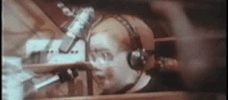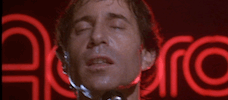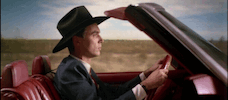Reviews
Neil Young
USA, 1972
Credits
Review by Leo Goldsmith
Posted on 11 December 2010
Source Torrent download
External links
Related music at Doom & Gloom from the Tomb
Categories Rock Follies
While many rock stars have had some kind of love affair with the cinema - from sinecurial dalliances to junkie obsessions to desperate, whorish embarrassments - few have had as lasting a passion as Neil Young. Beyond the requisite concert-film appearances (Rust Never Sleeps, The Last Waltz, Neil Young: Heart of Gold) and occasional talking-head documentary cameos, Young has produced a dozen feature films through his company Shakey Pictures, Ltd. and directed about a half of those, even shooting and editing a couple. In the late 1960s Young began experimenting with Super 8 film, a medium he would explore most fully in his 2003 “audio novel” Greendale. (Strangely, Young has only provided a full score for one film, but it’s a good one. His molten soundtrack for Jim Jarmusch’s Dead Man - for guitar feedback and idling ‘48 Chrysler engine, all more or less improvised - ranks as one of the best film soundtracks in recent memory.) And Young’s repertoire of songs is peppered with references to the movies and movie stars, from Marlon Brando’s anachronistic presence in “Pocahontas” to a song like On the Beach’s “Motion Pictures”, which obliquely suggests Young’s fascination with the medium as an analogue of memory. Harvest’s “A Man Needs a Maid,” inspired by seeing (and empathizing with) a character played by future partner Carrie Snodgress in the film Diary of a Mad Housewife, hints at an even deeper engagement.
Maybe the most telling instance of film criticism in Young’s musical oeuvre is the line that opens “Speakin’ Out,” delivered in a drunken, slightly mocking blues meter: “I went to the movies the other night,/The plot was groovy; it was outta sight.” The recording of the song would later surface on 1975’s Tonight’s the Night, but Young employed it first over the ending credits of his debut film, Journey Through the Past. Described by Young as a “documentary fantasy,” and exploiting altogether not enough of either of those polarities, the film is a forgivably “shakey” first film effort from Young. Its plot, if it’s “in sight” at all, is groovy to the point of seasickness, following Young’s career from the Buffalo Springfield to the then-present with a handful of quasi-allegorical excursions and larkish sidesteps along the way. But it’s nonetheless an essential document for Neil obsessives - if maybe no one else - offering a foggy window into Young’s narcissistic hippie dream (and nightmare) alongside some glimpses of the seedy pleather interior of early-70s rock stardom.
The film opens intriguingly with a visit by Young and his entourage to a radio station. With Woodstock veteran David L. Myers shooting 16mm, the group of guffawing, obviously stoned people wanders down a series of dark hallways and into the DJ’s booth, stopping in an office along the way so that Neil - unmistakable in the underexposed footage, towering over the others with a black shroud of hair and high, narrow shoulders - can sign an autograph for a peculiar, wizened, and wisecracking twelve-year-old named Gil. Once in the booth, Young smiles wryly as the DJ sets up the wrong tune, one he didn’t write: “For What It’s Worth”, the famed Stephen Stills peacenik anthem from the Buffalo Springfield days. Suddenly, like an involuntary memory, rare footage invades the screen showing the band “performing” the song (that is, lip-synching, albeit awesomely) on The Smothers Brothers Comedy Hour, before segueing into an energetic, but equally phony “Mr. Soul” with Neil on lead vocals, Western-fringed shirt, and bowl-cut.
This sequence - unfortunately the most elegantly assembled in the film - establishes a lurching rhythm that much of Journey Through the Past will follow, a non-sequitur excursion through the Neil Young Archive, with “present-day” rap sessions between Neil, Carrie, Graham Nash, and the guys about the old days, marijuana, and the music biz interrupted by live concert footage from the previous five years of Young’s career. The basic trajectory is one of increasing autonomy as an artist: from second fiddle status in Springfield to star appendix of CSNY to big-deal solo artist. This arc faithfully renders Young’s output at this moment - by 1972, had recently completed a big solo tour and scored a commercial success with Harvest, backed by his band the Stray Gators, whom we see rehearsing songs like “Are You Ready for the Country?”, “Alabama”, and “Words (Between the Lines of Age)” in Neil’s Northern California barn. (One shot even replicates the band-in-barn setup that’s pictured on the reverse cover of the Harvest record.) Appropriately enough, the musical-performance element of the film culminates with Neil’s solo performance of a hitherto unreleased song, “Soldier,” on piano.
But this is no mere documentary: it’s Young’s cinematic fantasy, in which non-sequiturs and involuntary visions predominate, and music is not the only way to journey through the past, present, or whatever. Keen on plumbing the allegorical depths of the late 60s and early 70s - and obviously tickled by the sort of logical leeway endorsed by Kubrick’s 2001, Godard’s Sympathy for the Devil, and Dennis Hopper’s Easy Rider and The Last Movie) - Young takes the opportunity for his fair share of oblique flights of fancy, casting a gaggle of his closest buddies and hangers-on. Local NoCal eccentric Gary Davis - identified as “Scary Gary” in Jimmy McDonough’s hefty Young biography, Shakey - talks in muffled tones to his red truck, which rides along Topanga Beach without a driver. The truck jovially talks back to Davis in the voice of another Young associate, James McCracken, whose miniature adobe temples are seen later in the film with bejeweled salamanders crawling all over them. Elsewhere, a berobed hippie called “The Graduate” (in the credits, at least) hitchhikes the American landscape from the desert to Vegas, occasionally menaced by religious weirdoes, and Neil, wearing a shiny construction helmet (premonitions of Human Highway), drops in to show the audience a boat-launch and to lead us around a junkyard, beercan in hand, identifying the models of various classic cars.
Perhaps the least flattering of all are the non-musical appearances by Young and his entourage, which at best glimpse a quietly, deeply stoned domesticity (Neil and Carrie smoking a joint, picnicking on a Tupperware of leftovers, and sipping from an enormous jug in the middle of a lovely country drive) and at worst dwell on Young’s compadres as they bloviate lysergically. Nash and Young comport themselves amusingly enough in a dumb stoner conversation about the idea of commercialized weed (“Wouldn’t that be far out?”), before Young spins an entertaining yarn about “turning on” for the first time in Toronto. (“Cuz no one got high. If you were high, you were Gene Krupa.”) Crosby and Stills, unsurprisingly, come off less eloquently: the latter softly mutters something about the superficial reassurances of language while, as the saying goes, “tripping balls”; the former delivering the following deeply earnest, precisely cadenced, and highly YouTubeable monologue:
I mean, man, on one side you’ve got a set of values that’s doom, death, degradation, and despair, being dealt out of the cards of the bottom of the deck by a gray-faced man who hates you. And on the other side you’ve got a girl, running through a field of—flowers, man. Half-naked and laughin’ in the sunshine. Now you offer those two alternatives to a child, and a child is too smart to make that mistake, man. It’s not gonna go for that gray-faced dude with the cards.”
Said “gray-faced dude” appears too - doing card tricks for young Gil the autograph-collector - as does Richard Nixon, but it’s the film’s coda that’s the real headscratcher. Back at the beach, black horsemen with peaked hoods and crosses ride towards a priapic monolith (name that movie reference!), while The Graduate opens his Bible, extracts a crucifix-shaped syringe, and shoots up. (Here’s Young singing “Soldier”: “Jesus, I saw you walkin’ on the river. / I don’t believe you. / You can’t deliver right away.”) In the film’s final moments, the Graduate wanders off in the company of a General, a Preacher, and a red-robed, wheelchaired Cardinal to the tune of the Beach Boys “Let’s Go Away for a While.”
Scenes like these suggest a Neil Young in the throes of the same kind of drugged-out self-importance we’ve previously heard from cohorts like Crosby, but the difference in medium is striking. Never the most articulate interviewee, Young seems desperate to express some ideas symbolically - or at least impressionistically - rather than to blather about them to the nearest enabler or groupie. Young’s fledgling film project may not be that interesting, coherent, or even good, but it does represent a level of ambition and insight that just barely peeks out of the usual post-60s miasma. Cinematographer Myers and producer L.A. Johnson (who henceforth faithfully collaborated on Neil’s films until his sudden death earlier this year) add a measure of technical stability to the film - this is not in fact such a shaky picture after all - even if Young would have been better served with a more assured hand at the Moviola.
But as this was the era of the lionized, Dylanesque singer-songwriter-artist, Journey Through the Past had to be Young’s show. And in any case, there are moments of wit and prescience, as in one scene in which the rich harmonies of CSNY’s “Find the Cost of Freedom” are rudely interrupted by an entourage member’s rant about escalating ticket prices, capitalist greed, and hippie hypocrisy.1 It’s not exactly an auspicious auteurist debut, but it suggests that Young’s interest in this sort of cinematic vanity project wasn’t simply a way of stroking his ego, but also a means to liberate himself from the usual rut of touring and music-industry flim-flam. Young has spent a career looking for ways of getting away for a while, from his brief career as a gentleman farmer to his more recent efforts to house a bio-electric engine in a 1959 Lincoln Continental. But the movies have remained one of his most consistent and rewarding sidelines, affording unguarded insights into the life and creative processes of a restless artist.
- From today’s vantage point, ten dollars doesn’t seem that much to pay even to see CSNY stumble through some stoner-jams, but the point still has immediate bearing in the face of this year’s monstrous Ticketmaster-Clear Channel merger and the new business model of the post-record-sales music industry.↩
More Rock Follies
-

Head
1968 -

Sympathy for the Devil
1968 -

Alice’s Restaurant
1969 -

200 Motels
1971 -

Journey Through the Past
1972 -

Human Highway
1982 -

Renaldo and Clara
1978 -

One Trick Pony
1980 -

Give My Regards to Broad Street
1984 -

The Man Who Fell to Earth
1976 -

True Stories
1986
We don’t do comments anymore, but you may contact us here or find us on Twitter or Facebook.



